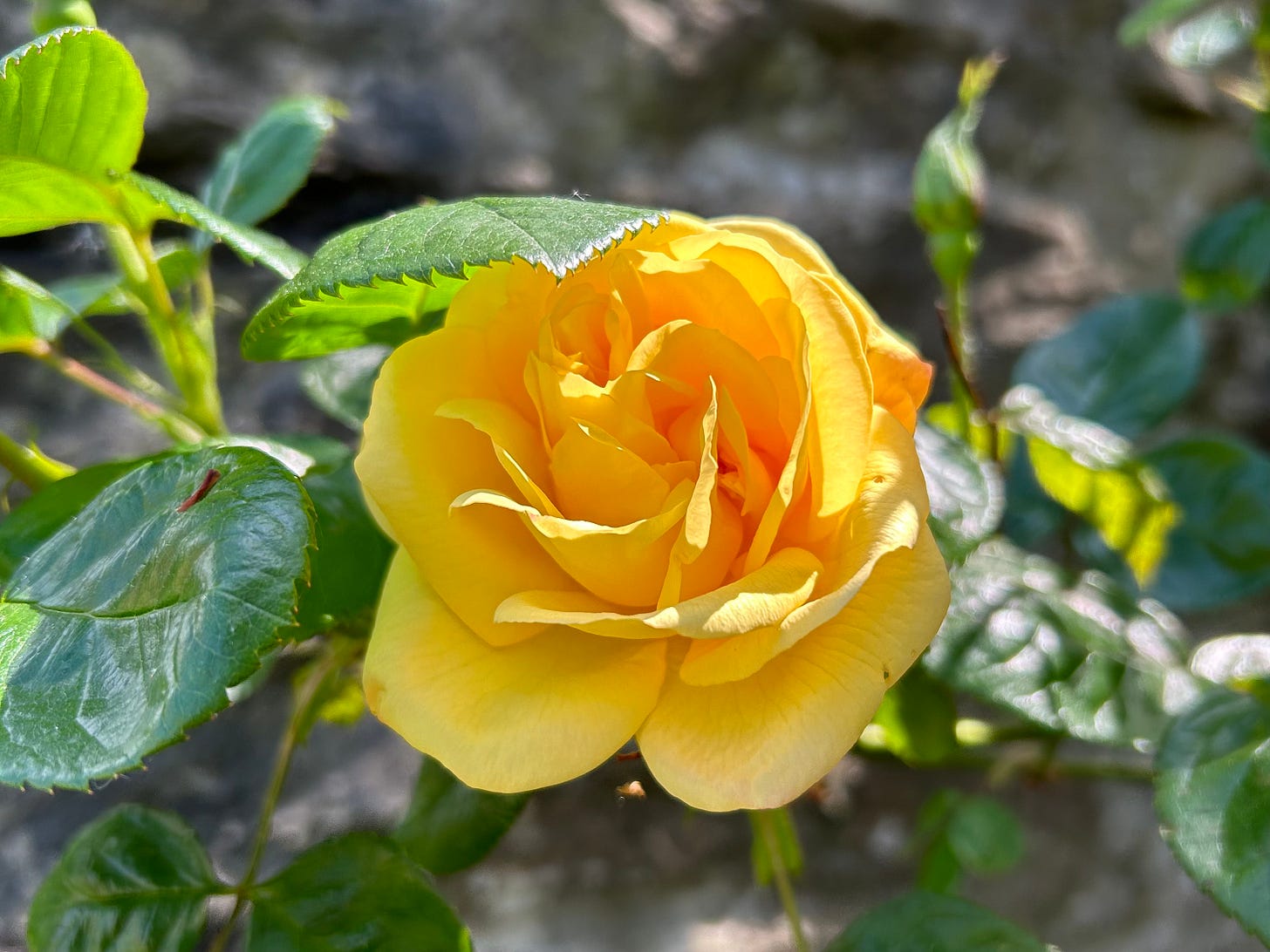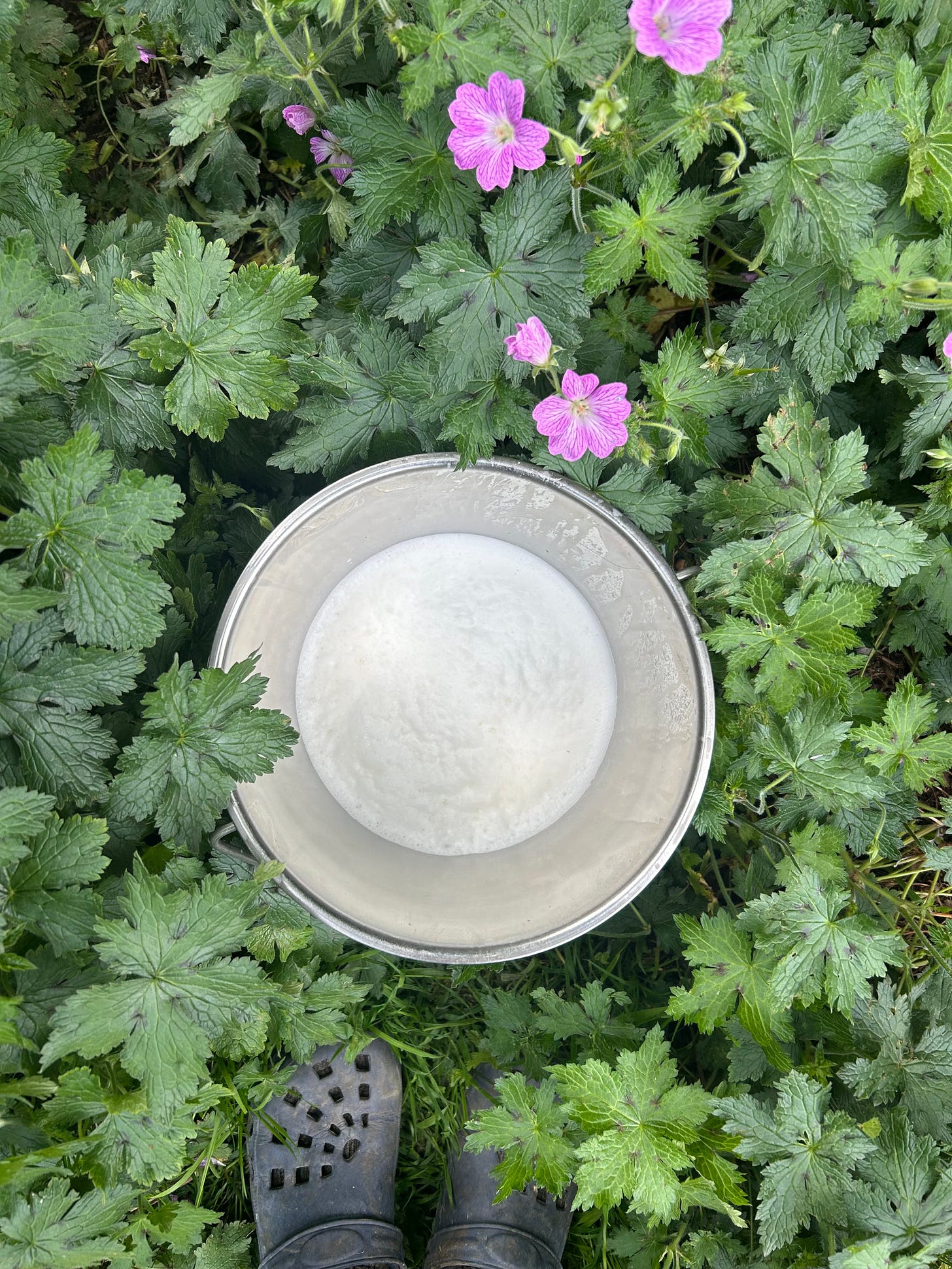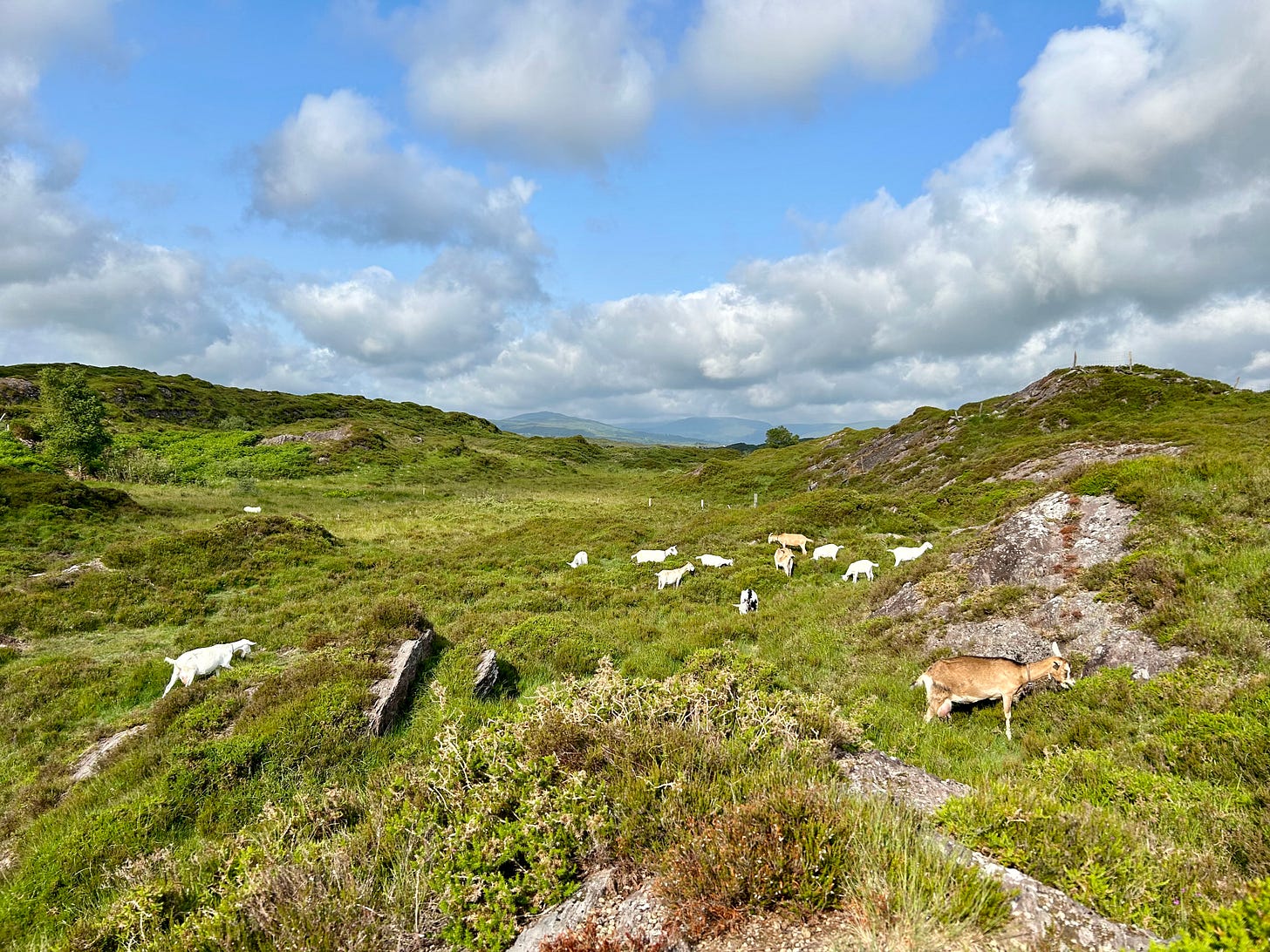Reciprocity
Greetings Readers, Hello Summer.
How is your summer/winter going? Thank you for still being here. I thought I had this post scheduled for last week, but something went wrong, and last Sunday when this should have been posted out I was tied up to-ing and fro-ing the goats in small family groups back the Hill for their summer freedom, as described below, so I took the failure as a cue to slow down and not rush back in before I’m ready. Here it is now, lightly amended. I have not turned paid subscriptions back on yet as my posting might still be erratic and I’m figuring out how to keep up with this commitment sustainably while also juggling the seasonal demands of the real life farm that feeds these stories going forward—I’ll let you know when I do, in a few weeks. I have a few half-written stories to share with you in the coming weeks and months, but mostly I have spent these last eight weeks or so well away from the screen, being fully present in the real and tangible world I live in, getting to know this ancient, magic place we have come to make our home and watching our first spring into summer here unfurl from sticks and twigs into mounds of voluptuous green and blossoming lace.
The old, dying hawthorns the goats and I spent winter relieving of smothering bramble and ivy burst back into life and offered their blooms for medicines and honey. A grove of wild cherry appeared, sparkling with the morning dew and delicately laced with tiny white flowers. The old apples in the orchards long lost to rampant brambles that we cleared and fed and brought back into the light blossomed and hummed with life and set with fruit. Old-fashioned, lemon zest-scented roses bloomed from the old stone beds we cleared of bindweed and nettle and layered with a fresh quilt of manure. The roses here are forty years old or more, planted and tended by hands long passed and then left to the years of neglect. I cut away the dead wood and fed each with a healthy handful of composted poultry manure and now they repay with a display of colour and scent, offering a buffet for hoverflies and honeybees. Swallows are nesting in the rafters of every old building here they can access, including the buildings we’re trying to renovate, our freezer room, and the outhouse. They use our farm ducks’ fluffy white down to line their nests. They dive-bomb us on our daily forays to the freezer and we have to duck and be quick about it when we want to use the toilet. This is their old abandoned farmstead after all, and we are the intruders. Tiny wild strawberries blush as they tumble down stone steps and run along the paths. The gooseberry bush I found smothered under the wildness reclaiming the orchard, that I carefully untangled from the brambles and fed with more of that composted poultry manure, is now bowing heavy in reciprocation with the gifts of her fruit.
That gooseberry bush, those apples and these roses got me thinking about this exchange of nurture we call domestication. There was I murmuring sweet nothings to the gooseberry as I cut back the nettles that have sprung up everywhere light now touches rich, dark soil, admiring her tiny green bell flowers that are now swelling with fruit, and here was an old, long-neglected garden of heritage fruits and flowers reviving and blooming, remembering the touch of human care. If the season is willing, we may just be rewarded for our all labour and compost with a glut of apples, gooseberries and blackcurrants come late summer.
All through the orchards where the goats and I cleared of bramble, nettles have marched in to fill the space. I’ve been cropping and drying the nettles to feed back to the goats this winter when fresh forage falls back and the does gestate their babes in the comfort of their barn. At this stage in the season, all of this year’s buck kids have either been weaned or butchered, grown fat on their mothers’ milk churned from those brambles and lush spring pastures carved into the land by farmers and their herds before us. It doesn’t take long for uncastrated buck kids to reach a size and stage of maturity whereupon it’s a relief for everyone to see them gone. Mother goats and their doe kids are now settled into the order of the matriarchal herd, and all our sleepless nights of goat midwifery and nannying are transmuted into milk and meat.
Last week, we trailered the female herd in three small, family groups two and a half miles up a rough, gravel road back to the Hill they know as home where our milkers and mothers will spend summer churning sweet heather and all the wild forage of the open Hill into sweet ambrosia, and showing their doe kids the ways of the wild land. Our pampered, precious doe kids, the ones we carried across the snow to browse on brambles when their mother needed fresh greenery in January, the ones I pulled steaming from their mother into the grey dawn of winter, the ones born in a warm stone temple heated by the breath of a dozen living, belching furnaces, the ones raised until now on lush little fields of pasture and wood doled out to them by daily fence moves, Molly’s triplets and Sally’s twins, must now learn to navigate the rocks and weather and forage on the open Hill. Three times a day since then I have made that same two and a half mile journey to check, feed, milk and tend the herd. I hope to have that down to a twice daily routine before too long.
Those of you who’ve been following here for some time will be familiar with my usual trope on letting the herd live by their own intelligence, trusting in the herd’s innate, wild wisdom and capacity to take care of themselves. Well now I’m going to do a u-turn and give that some context. These are not wild animals—they are animals which have evolved over thousands of years and thousands of generations in codependence with us, their herders, their keepers, their humans. We trim their hooves and salve their wounds, we fight for them when they would surrender too softly to sickness and death. We keep them safe from predation, give them shelter and saved feed when the land lies bare. We raise their young when they can’t. Yes, that makes them soft. Has made them soft and dependent on our care.
Our goats are smooth-coated, sun-loving, highly domesticated dairy breeds that aren’t made for our wet, seasonal climate. We’ve given our hardiest goats of a line bred and raised in these hills periods through dry, warm summers out on the land to fend for themselves (with me making a daily trip to the land to check on them and give a little extra feed when needed) when they were not in production and only had themselves to fend for, and saw them blossom with the heather and freedom to find their own sustenance. I have learned more from watching our herd live and feed themselves relatively freely than any book on husbandry has taught me. But, they would not thrive on their own for long when the forage falls back and the weather is wet and wild in winter. They would not survive to rear their young into the wild—at least not without cruel strain and losses. Left to the wild they would struggle like our old, abandoned orchards, wither like the plum tree we found with more dead wood than living, strangled by brambles and starved by neglect. I wouldn’t dream of leaving our more delicate, highly bred ladies from lines raised in barns and flat green fields to fend for themselves on the Hill without shelter and feeding, or without a strong leader goat who knows the land. They wouldn’t do at all.
We’re asking our domestic animals to produce more than they naturally would—and they have developed bigger udders with higher yields which need to be milked in response to our hunger. Just as the apple has sweetened and fleshed out her fruit to our taste, and the gooseberry bows with her gifts in return for sustenance. Our dairy goats birth more babes than they could naturally raise—twins or triplets are usual, quads and even quintuplets are not uncommon. Consider Ireland’s hardy, feral landrace, the Old Irish Goat, hunted almost to extinction, whom normally birth one, maybe two, as many as they can raise into the limits of their landscape. Prolific litters in domesticity are not a response to predation, survival in numbers, but a response to our feeding and care. We prune and feed the pear to encourage her fruit, and we save the sweetest pastures for our herd to encourage their flow of milk and meat. It is a dance of reciprocity which has been trodden into the life-ways of human and herd through millennia.
The herd run as free as we can let them within the limits of the land available to us and our climate, to choose their own forage and go where they please. They know their land. They know the paths across the bogs and where to catch the afternoon sun high on the rocks for the best siesta spot. They know how to scrape lichens off the rocks, how to delicately pick marsh thistle flowers between their prehensile lips, and where the willows grow. They know that if they stare at me imploringly with those buttery brown eyes I’ll go with them and pull down the branches they can’t reach. They also know that fresh water comes in a yellow bucket and precisely what time to be back in the barn for their little bit of extra feeding, milking and settling into a warm, dry bed for the night (they also know to make a lot of noise to alert me, their humble servant, that it’s feeding and milking time, lest I forget). And on any summer rain day, given the choice, my ladies much prefer to loaf around indoors and take full advantage of room service than get their satin coats wet out foraging.
I think it’s a reasonable exchange, my service for their sweet ambrosia churned from bramble, heather, nettle and moor grass, the cream of the land that continually reminds me of my place as gardener and herder, as human, enmeshed in a web of nurture for nourishment and life for life—a web of reciprocity.
Thank you for reading. It’s good to be back.









It's good to read this update from you, Carly, and know that you are enjoying summer, and too busy tending to life and land to be bothered in front of a screen very much. I too have been enjoying summertime, and am reluctant to spend much time typing out my thoughts on it. I am living my life, and the world of the internet can wait.
Something I thought while reading this: I love how much depth of meaning can be packed into a capitalized word: Hill. Your words about the animals fending for themselves on the open Hill, coupled with what you have already shared so much about in your other writing, conjures an image in my mind that can only be compared to poetry. That only a single word can sum up for the imagination what long pedantic articles would struggle to explain to our left brain centred world is a marvel to me.
Welcome back!